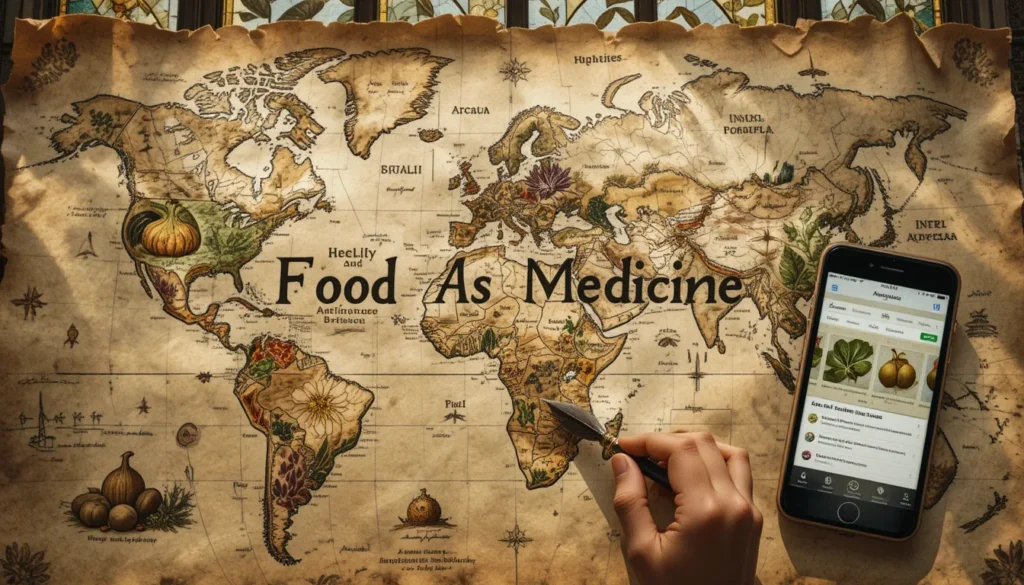Table of Contents
Introduction

Delve into the fascinating world of Food As Medicine and unearth the wealth of nutrient powerhouses waiting to be discovered in every corner of the globe.
From exotic superfoods to humble kitchen staples, the healing properties of various ingredients have been cherished by ancient civilizations and modern science alike.
Join us on a journey to explore the diverse flavors and health benefits that different cuisines have to offer, and unlock the secrets of using food to nourish both body and soul.
Historical Perspectives of Food As Medicine

Ancient Traditions and Practices
An exploration into ancient traditions and practices reveals a wealth of knowledge about the healing properties of food. Civilizations such as the ancient Egyptians, Greeks, and Chinese utilized specific foods and herbs to prevent and treat various ailments.
These ancient healing practices laid the foundation for modern-day nutritional therapy and herbal medicine.Herbal remedies, dietary restrictions, and the concept of Food As Medicine were deeply ingrained in these ancient cultures.
The belief that nature provides all the resources needed for healing informs many traditional healing systems that continue to thrive today.
Development over Centuries
Development over centuries saw the refinement and expansion of nutritional healing practices. As civilizations traded goods and knowledge, the understanding of food’s medicinal properties grew.
Traditional healing systems merged with new discoveries, leading to the development of diverse culinary traditions rich in both flavor and health benefits.
Centuries of experimentation and observation have contributed to our current understanding of the link between nutrition and health. The wisdom of our ancestors continues to guide us as we explore the potential of Food As Medicine in the modern world.
Nutrient Powerhouses Around the World

Food As Medicine in Different Cultures
With a diverse range of cultural traditions and culinary practices around the world, it’s no surprise that each culture has its own set of superfoods.
In Japan, seaweed such as nori and wakame are staples in the diet, known for their high levels of iodine and minerals. In India, turmeric is a common spice used in cooking and is revered for its anti-inflammatory properties.
And in South America, quinoa is a nutrient-dense grain that has gained popularity worldwide for its high protein content.
Exploring Food As Medicine from different cultures not only adds variety to our diets but also exposes us to a wider range of nutrients and health benefits. By incorporating these superfoods into our meals, we can take advantage of the unique nutritional profiles that each culture has to offer, promoting overall health and well-being.
Unveiling Hidden Nutritional Gems
Different regions of the world are home to a treasure trove of hidden nutritional gems that have been used for centuries for their health benefits.
From the baobab fruit in Africa, known for its high vitamin C content, to the moringa leaf in Asia, praised for its rich source of antioxidants and amino acids, these lesser-known ingredients are now gaining recognition for their exceptional nutritional value.
Superfoods like these are not only delicious but also provide a natural way to boost our immune systems, protect against chronic diseases, and support overall vitality.
By incorporating these hidden nutritional gems into our diets, we can harness their potent health benefits and enjoy a more vibrant and nourished life.
Scientific Understanding of Food As Medicine Connection

Nutritional Biochemistry Explained
The use of Food As Medicine has long been established, with the field of nutritional biochemistry shedding light on the intricate ways in which nutrients interact with our bodies at a molecular level.
Nutrients such as vitamins, minerals, antioxidants, and phytochemicals play vital roles in various physiological processes, influencing our health and well-being.
Understanding the bioavailability of nutrients, their absorption, metabolism, and excretion is crucial in unraveling the mysteries of how food acts as medicine.
The synergistic effects of different nutrients working together to promote health, prevent disease, and even treat certain conditions highlight the importance of a diverse and balanced diet rich in nutrient-dense foods.
Clinical Studies and Evidence of using Food As Medicine
Food As Medicine has evolved beyond traditional wisdom and anecdotal evidence, with a growing body of clinical studies supporting the use of food as medicine.
These studies provide scientific validation for the benefits of specific foods and dietary patterns in the prevention and management of various diseases, ranging from obesity and diabetes to heart disease and cancer.
This section will delve into the latest research findings and key clinical trials that have shaped our understanding of the Food As Medicine connection, highlighting the power of specific nutrients and food components in promoting optimal health and wellness.
Incorporating Nutrient-Rich Foods into Your Diet

Practical Tips and Recipes
When it comes to incorporating nutrient-rich foods into your diet, start by adding a variety of colorful fruits and vegetables to every meal. Berries, leafy greens, bell peppers, and sweet potatoes are all excellent choices that are packed with vitamins, minerals, and antioxidants.
Try adding a handful of berries to your morning smoothie or tossing some roasted sweet potatoes into a nourishing bowl.
Experiment with different herbs and spices to enhance the flavor of your dishes while reaping the health benefits they offer. Turmeric, ginger, garlic, and cinnamon are just a few examples of spices that have powerful anti-inflammatory properties and can support your overall wellness.
Knowing how to build a balanced plate is key to ensuring you’re getting a variety of nutrients in every meal. Aim to fill half of your plate with colorful vegetables, a quarter with lean protein sources like fish or beans, and the remaining quarter with whole grains or starchy vegetables.
This simple guideline of using Food As Medicine can help you create nutritious and satisfying meals that support your health goals.
Preparing Meals for Optimal Health
Recipes for incorporating nutrient-rich foods into your diet don’t have to be complicated or time-consuming. With a little planning and some simple techniques, you can prepare delicious and nourishing meals that support your overall health and well-being.
Preparing meals for optimal health involves choosing ingredients that are rich in essential nutrients and then combining them in creative ways to create flavorful dishes that you’ll love.
Experiment with different cooking methods like roasting, steaming, or stir-frying to bring out the natural flavors of your ingredients while preserving their nutritional value.
Challenges and Considerations when using Food As Medicine
Not only is food a source of sustenance and pleasure, but it also plays a crucial role in our overall health and well-being. However, there are several challenges and considerations to keep in mind when exploring the concept of Food As Medicine.
Accessibility and Sustainability
Challenges related to accessibility and sustainability can greatly impact the ability of individuals to benefit from the nutrient powerhouses found in different corners of the world.
While some foods may offer exceptional health benefits, they may not be readily available in all regions or may come with environmental concerns related to cultivation and transportation.
Addressing issues of accessibility involves promoting local and seasonal eating, supporting sustainable farming practices, and advocating for policies that ensure equitable access to nutritious foods for all communities.
By prioritizing locally sourced and sustainably produced ingredients, we can reduce our environmental footprint while supporting our health and the well-being of future generations.
Cultural Considerations in use of Food As Medicine
Cultural preferences and dietary habits can also pose challenges when it comes to incorporating nutrient-rich foods into our diets. While certain foods may be celebrated as superfoods in one culture, they may be unfamiliar or unappealing to individuals from different cultural backgrounds.
Respecting cultural diversity and honoring traditional culinary practices is essential in promoting food as medicine in diverse communities.
Educating individuals about the health benefits of their traditional foods and providing resources for incorporating these foods into modern diets can help bridge the gap between cultural heritage and contemporary nutrition recommendations.
Economic Barriers in the use of Food As Medicine
Economic factors can create barriers to accessing nutrient-rich foods, particularly for low-income individuals and communities. Fresh fruits, vegetables, and other healthy ingredients may be more expensive or less accessible than processed and convenience foods, which can contribute to disparities in diet-related health outcomes.
Addressing economic barriers to healthy eating requires a multi-faceted approach that includes increasing access to affordable nutritious foods through initiatives such as community gardens, farmers’ markets, and food assistance programs.
Additionally, policies aimed at promoting fair wages, reducing food deserts, and incentivizing healthy food choices can help make nutritious foods more accessible to everyone, regardless of socioeconomic status.
Nutritional Education
Lack of nutritional education and culinary skills can hinder individuals’ ability to make informed choices about their diets and effectively incorporate nutrient-rich foods into their meals. Without a basic understanding of nutrition and cooking techniques, people may struggle to identify healthy food options and prepare them in ways that preserve their nutritional value.
Investing in nutrition education programs and culinary training initiatives can empower individuals to take control of their health through food. By providing resources and practical skills for meal planning, shopping, and cooking, we can empower individuals to make healthier choices and improve their overall well-being.
Food Industry Influence
The influence of the food industry, including marketing tactics and the prevalence of ultra-processed foods, can undermine efforts to promote food as medicine. Highly processed foods high in sugar, salt, and unhealthy fats are often cheaper and more widely available than whole, nutrient-rich foods, making them attractive options for consumers.
Addressing the influence of the food industry requires advocacy for policies that prioritize public health over corporate profits, including regulations on food labeling, advertising to children, and the marketing of unhealthy products. Empowering consumers with knowledge about how to navigate food choices and critically evaluate marketing claims can also help counteract the influence of the food industry on dietary habits and preferences.
Conclusion

In conclusion, the concept of Food As Medicine offers a holistic approach to health and wellness that celebrates the healing power of nutrient-rich foods from around the world. By exploring ancient traditions, scientific research, and practical strategies for incorporating superfoods into our diets, we can unlock the potential of food to nourish both body and soul.
While there are challenges and considerations to overcome, including issues of accessibility, cultural diversity, economic barriers, nutritional education, and food industry influence, addressing these challenges is essential in promoting equitable access to nutritious foods and empowering individuals to make healthier choices.
By working together to prioritize sustainability, cultural diversity, and public health, we can harness the transformative power of food to create a healthier, happier world for generations to come.
FAQs
Q1. What are superfoods, and how do they contribute to overall health and wellness?
Superfoods are nutrient-dense foods that are particularly rich in vitamins, minerals, antioxidants, and other beneficial compounds. Examples include berries, leafy greens, nuts, seeds, and fatty fish like salmon.
Q2. How can individuals overcome economic barriers to accessing the use of Food As Medicine?
There are several strategies individuals can employ to overcome economic barriers to accessing nutrient-rich foods and use Food As Medicine These include:
Prioritizing budget-friendly options, Shopping at local farmers’ markets, Participating in community-supported agriculture programs or food cooperatives, Taking advantage of food assistance programs, Planning meals ahead of time, buying in bulk, and cooking at home to reduce food waste and save money on overall food costs.
Q3. What role does cultural diversity play in shaping dietary preferences and health outcomes?
Embracing cultural diversity in food choices can enrich our diets by introducing us to a wider variety of flavors, ingredients, and cooking techniques.
However, cultural differences can also contribute to disparities in health outcomes, as certain dietary patterns may be associated with higher risks of chronic diseases such as obesity, diabetes, and cardiovascular disease.
Q4. What are some practical strategies for incorporating nutrient-rich foods into everyday meals?
By incorporating these practical strategies into your meal planning and preparation routine, you can enjoy delicious and nutritious meals that support your health and well-being.
Q5. How can consumers navigate the influence of the use of Food As Medicine?
Consumers can navigate the influence of the food industry and use Food As Medicine by:
A- Reading food labels carefully and paying attention to ingredients lists, nutrition facts, and serving sizes to make informed decisions about the products they purchase.
B- Being skeptical of marketing claims such as “low-fat,” “natural,” or “organic,” and critically evaluating whether a product’s health claims align with its nutritional profile.
C- Choosing whole, minimally processed foods over highly processed and ultra-processed foods whenever possible, as these tend to be higher in nutrients and lower in added sugars, salt, and unhealthy fats.
D- Supporting companies and brands that prioritize transparency, sustainability, and ethical business practices, and avoiding products from companies with a history of unethical or misleading behavior.
E- Educating themselves about nutrition and cooking skills to empower themselves to make healthier choices and prepare more meals at home using wholesome ingredients.
F- Advocating for policies and regulations that promote public health, such as restrictions on junk food advertising to children, labeling requirements for added sugars and unhealthy fats, and incentives for companies to reformulate products to make them healthier.
By taking a proactive and informed approach to food choices and advocating for policies that support public health, consumers can navigate the influence of the food industry and make choices that promote their own well-being and the well-being of their communities.







